New Comic Book Day: Steve Orlando Talks Virgil
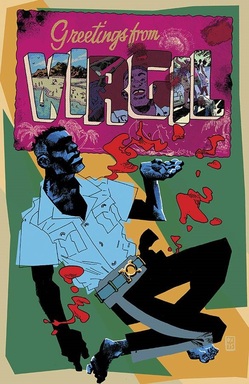 |
| Image Comics |
| Click to Enlarge |
Steve Orlando made headlines earlier this year as he helped launch Midnighter, the first ongoing comic from the big two to star an openly gay man. Later this month, he gets the chance to revisit an earlier work. Virgil, a queersploitation story about a gay, Jamaican cop outed, beaten and humiliated for his sexual orientation, was originally funded through Kickstarter. Next week, this tale, written by Orlando with art from JD Faith, Chris Beckett and Thomas Mauer is being released beyond the initial KS backers by Image Comics. Steve sat down with me to talk a little about the book and how it (and he) have changed since Virgil was first conceived…
Jim Dandeneau: Can you tell me a little bit about how the team came together? I know it was a Kickstartered book that Image is now rereleasing with some additional material, but how did you guys originally find each other and decide to tell this story?
Steve Orlando: In the case of Virgil, the team actually came together before the idea. JD and I were both in an anthology published by a smaller publisher called Draw More Ink; it was called Nobodies. And It was about doing a book where we would have a hard copy full of our work to show to editors and things. And I guess it worked because when I got my comp copies, I saw JD’s story, and he saw what I did actually with Artyom [Trakhanov] from Undertow, and we contacted each other and wanted to work together. So we came together through that anthology. I came together with Chris Beckett through my friend Greg Lockhart at Vertigo. They had known each other, and Chris had done some comic work for Smallville at DC. And we sort of came together through those sort of “people who know people in comics” stories. I’m not neglecting Thomas Mauer either. Thomas is my sword in the stone when it comes to design and everything. He’s always on board with whatever type of craziness I’m doing.
So we knew that we wanted to work together, and develop this sort of unique visual style. JD is very into doing some type of neon noir, and I was totally into that as well. We had all just seen Drive, and were very excited about doing something that had the color pink in it. And we hadn’t seen Only God Forgives yet, so we thought that that was somewhat of a good idea. So we knew we wanted to work together, and we knew we wanted to do noir, and I knew I wanted to do queer noir, because this was just around the time that Kevin Keller came into Archie. And I was like “look, what is more dogmatic than Archie?” If we can infuse gay characters, queer characters into Archie and have it work and have it not be a big deal, like, where can I do this in the genre? And I don’t really write about drama about what color we should paint the homecoming sign, I write about people hitting other people, so it had to be a different type of genre. So we decided it was going to be noir.
As to how we came into the precise story of Virgil, an outed cop out for revenge in Jamaica, it was all thanks to Quentin Tarantino making a movie about racism being bad and calling it edgy. I walked out of Django Unchained and I was like “this was an entertaining piece of exploitation and revenge cinema.” But all these reviews saying that “oh this is an edgy movie,” what are you talking about? It was 2013, 2012. Nobody thinks that the idea that racism is bad is a bold idea. If you don’t agree with that, you’re a giant jackass. So I walked out and I was like “Well, if this movie was ballsy, and it really wanted to be disruptive, Django would have been gay.”
…So I sat there and I was in the artsy housewife theater in Albany where I live, and I was like “Well why the fuck should I wait for someone else to do this? I’m just gonna do it.” And that’s how Virgil came together. We knew it was going to be queer exploitation cinema. The final piece came, I was doing research actually about Sub-Saharan Africa, which also doesn’t have a great track record with its treatment of the queer community, and I came across all these articles including a 2006 Time Magazine article saying that Jamaica was the most homophobic place on the planet. And that was legitimately shocking to me. So I decided I had to do more, read more, and the more personal accounts I read and the more news reports and documentaries and social media pieces I got into, I realized it’s just something I wanted to try to give respect to and spread the word about. Because it is something that not everyone would think is happening, and it’s shocking the way that the community is living there. So if we were going to do noir and going to do exploitation, we had to do what comics are supposed to do and that’s take people somewhere they’ve never been before or they can’t afford to go or they never would think to go. So that’s how we landed in Jamaica with Virgil as you read it today.
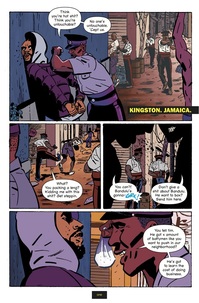 |
| Virgil Preview |
| Virgil p1 – Click to Enlarge |
JD: I was going to ask why Jamaica when there are plenty of other countries with similarly reprehensible attitudes towards LGBTQ people, but when you mention taking somebody where they’ve never been before, even though Jamaica is that idyllic vacation destination in a lot of peoples’ minds, there is a world away from the resorts there, and I think what Virgil shows and what some of the subsequent research that I did also shows is that Jamaica’s a pretty shitty place to be gay.
SO: It’s not a great place, and that’s the thing. It’s a resort destination, and it’s a place where large swaths of the gay community actually live in storm drains. The contrast there…if you’ve seen, I always mention this because it’s easy to take in, it’s about 25 minutes, a half hour. It’s a Vice Media documentary called “Young and Gay: Jamaica’s Gully Queens.” All you need to do to understand why this is something people need to know about and it’s gripping, is just watch that documentary, and you see the state and the self-fulfilling prophecies and hypocrisy that the community is facing. You have people there forced out of their homes and forced away from their families, they’re living homeless. You know, when people are asked by interviewers, they say “These people should just get jobs.” And [the interviewers ask]“Why don’t you hire them?” and they say “Well, would you hire someone who looked like that?” They create the situation in which the community can be oppressed, and they’re both the cause and the excuse. So it’s a crazy situation that really, for people who just go there and stereotypically smoke a doob and sit on the beach, not everyone is doing that.
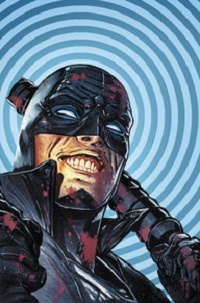 |
| DC Comics |
JD: One of the things that I’ve noticed with your writing, not just on Virgil, but on Midnighter, is that there isn’t really any sensationalization. That may not be the right word, but the violence and the sex scenes, whereas five years ago might have been played for titillation a little bit, in Midnighter and Virgil, it’s just kind of there, it’s just presented matter-of-factly. Is that something conscious on your part, or is it more a reflection on kind of where we are as a society and what I’m bringing to reading it?
SO: No, I think it is a big push. When it comes to doing, especially with issues of sexuality. One of my biggest qualms with stories is when they…there’s good intentions behind it, but they seem to want people to know, the creators want people to know how okay they are with a given thing that they end up putting undue spotlight on it and fetishizing it in a way that makes it not normal. It makes people stare at it and linger on it… It’s like if you were walking next to me on the street and you were like “OH EVERYBODY LOOK, I’M WALKING NEXT TO A QUEER JEWISH PERSON. LOOK AT HOW OKAY WITH IT I AM!” The result is not what you intend.
So yeah, I try to even have some narrative to treat those elements that way. We spend as much time on it as we would if they were heterosexual elements, and when it comes to the violence, it’s the same thing. In a weird way, I don’t want to pass judgement on it. As you said, it is what it is, and really, it puts it on the reader to decide. These things are happening. Do you think it’s ugly? Do you think it’s justified? That is something, especially in Virgil, that comes from the exploitation side of things, which always presented sexuality and violence in a very opaque, very bold way, without any sort of fear of repercussions. And even when it happened, in the case of a movie like Sweet Sweetback[‘s Badasss Song], Mario van Peebles had unsimulated sex when he was like 11 or 12 years old with a woman on screen and there was a huge controversy. And that’s not to say that that’s a good example. No one lost their virginity making Virgil.
JD: Maybe someday because of it?
SO: [Laughs] But that is the point, you know? The sex and the violence are things that are bold and they’re primal and they’re raw, and especially in the case of exploitation, it’s because it is this sort of low-fi, unfiltered place of emotion that the stories are building from. So you can’t take the time to think or second guess, and neither can the story.
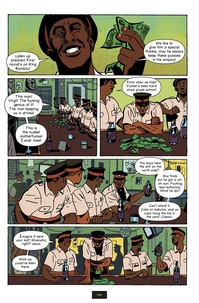 |
| Virgil Preview |
| Virgil p2 – Click to Enlarge |
JD: And by the same token, the same way that the sex and the violence are not sensationalized, neither is Virgil’s existence as a cop in a corrupt system. He is clearly, at the beginning of the book, on the take, and even later on when we learn that he’s intending that money towards a positive end, he’s still a crooked cop.
SO: Of course! Virgil’s not a superhero, and I think that’s important for the story. He, in an effort to make him sort of relatable but also imperfect…I don’t like utopian stories. Virgil starts out in the closet. He starts out in a position where he thinks he has power. He has a gun and a badge, but it actually doesn’t mean anything. The true power comes from accepting himself and becoming the person he was hiding. But some stories wouldn’t start there. Some stories he would always be out and proud, and I think that in certain contexts that’s powerful, but it’s not necessarily realistic.
We live in a world that’s like, if no one calls him a cocksucker in this book, it would be pretty strange, because he’s in Jamaica. We live in a world that’s not utopian. We live in a world where aggression towards people exists regardless of what minority you’re in, and so there are certain stories that can deal in that type of person, but I think it’s more gripping to make Virgil a real person and make him a person with problems who’s not perfect and then see him rise above those things. If he were the only straight cop on the force (for lack of a better term), you’re already like “this guy is a saint.” Nobody knows a saint, but everybody knows a person that has made compromises to get by, and that’s something we all do as adults.
So I think that that is vitally important to what we’re doing, and I wanted to have him, not just with how he is on the police force, not just his dealing with his sexuality, but with his own point of view on life in Jamaica. You see he has expectations and pessimistic views of his friends in the story that actually don’t serve him. He judges them wrong because he expects things to be as bad as possible, and that hurts him as well. A big part of the inspiration for Virgil, these exploitation films, a big part of them is dealing with the problems within and without, and so it was important to me not to just have these like, archetypal, hating villains and angelic heroes, but have people on both sides that are living in the shades of grey in between.
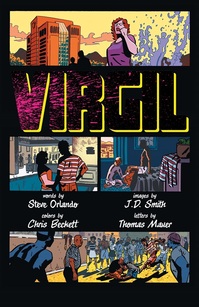 |
| Virgil p3 – Click to Enlarge |
JD: Over the course of the story, he gets the living piss beat out of him, but he keeps on coming. That Terminator-like resiliency is a huge part of exploitation, but was there ever any concern that you were putting him through too much, that you were turning him from Virgil into Wolverine?
SO: In a different type of story, perhaps, but as you said, the world of exploitation is a hyper-real world, in all ways. So I didn’t…he goes through a lot, certainly, but we’re dealing with a social myth, we’re dealing with an urban myth here. So I think that this part of the superhuman stamina that you see is part and parcel to the story. Certainly he takes a beating, and it wears on him throughout the book, but it feeds the idea that essentially he’s been on an adrenaline rush doing this thing, throughout the entire course of the book. When he hits a wall, it’s all going to come crashing at him, but to that point, he’s running in the red the entire story.
JD: And it does pay off towards the end. And I think that the way that JD blocks out the fights also does a good job of keeping things realistic, even though the violence is hyper exaggerated. How did you guys work? Tight script? Marvel style? I feel like I always ask this in interviews, but it’s always fascinating to me to figure out the group dynamics behind the creation of these books.
SO: The thing is, is that I always work full script, but at the same time, I don’t think my job is done as soon as I press send on that script. So what I mean by that is, I don’t work Marvel style, but I always expect that when I write a script, if an artist has a better way to do something, I fully expect them to pursue that. That is not a big deal, and I’ll amend the script to match it after. We worked full script, and we worked the beats into the page, but knowing that the conversation is going to continue after I send that to JD. It’s going to continue at the layout stage, and the pencil stage, to sort of see exactly how he can best accomplish the beats that are laid out on the page. That comes from a place of collaboration. Not I know better than you or vice versa. it’s like how can we push each other, how can we do our thing but push each other to be better all the time, and check each other’s excesses, and make sure that everything we’re bringing to the book, we’re bringing the best that we can.
It’s really about giving each other the room to work when it comes to Virgil, but also keeping each other honest – like when it comes to my script, if I’m getting too wordy, or if I’m getting too obsessed with language, or any of those things. Because I’m from central New York. If I had my way, people would say fuck in any book that I write more than all characters in movies combined. It’s all about, you have to be completely open, you have to be completely without ego, and be ready to bust each other’s chops with the idea that the book is going to be better at the end and the best vision of what you can do, completely separated from your own opinion of your ability. And that’s what we do. Nothing is off the table when we talk about each other’s work on Virgil, and it’s all about making each page as good as it can be.
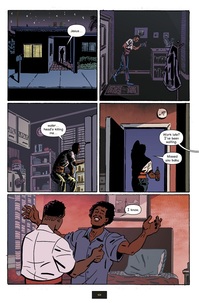 |
| Virgil Preview |
| Virgil p6 – Click to Enlarge |
JD: Chris Beckett’s colors in particular on the art are outstanding. There are a lot of palate cues that he, I guess hides in the work. I’m thinking specifically of the sequence where Virgil and Ervan first have sex. Those colors are inverted, or reversed, I guess, from the brothel scene earlier in the book. How much of the structure of the story was built with the color theory in mind, or was it just something that Chris brought to it and was like, a happy accident?
SO: That is something that evolved over the course of our collaboration. I knew at the start that JD was going to want to work with the colorist to create a signature coloring style. Knowing that, again, from my point, as a writer it’s all about knowing your collaborators and trusting them to get it done. So all I had to do was write things that I knew they could fit in some amazing lighting effects, and then be like “alright guys, now do what you said you were going to do.” And luckily, they were able to. So the scene with Virgil and Ervan, the boudoir lighting and the brothel scene, from the minute I wrote the final chapter, what was originally issue 4 before it was an OGN, of Virgil just sort of silently driving the police car after the precinct scene, was made just for JD and Chris to play with lighting. And having said that, it’s my favorite sequence in the book. The buildup to the final showdown with him driving the police car, I would frame that and put that in my house. There’s nothing that sums up the book more, and it’s a scene where he doesn’t say anything. I think they crushed it on that, and they did something really special. I’m excited that you got to see it, and I’m pretty excited for other people to get to see it too.
JD: Can you talk a little about how the Image release has changed from the Kickstarter release?
SO: It has developed….I wanted them to be different. Not only on the surface: Kickstarter has a different cover, it’s a hardcover versus a softcover. The Image version is refined as is necessary by the two years in between the Kickstarter and the new release. I was able to have people that backed the Kickstarter that are queer and living in Jamaica reach out to me and give their opinions. Everyone was excited that we were talking about what was going on, and for the most part, they were like “Yeah, you guys nailed it.” There were some things they were like “Well, this is maybe a little too much, and this is how maybe this would happen.” Even if there were small word details or little character notes about how things would be said or how things would be done, that’s all invaluable things we’d put into the new edition.
I mean, yes, we’re writing queer noir, and people on the team are queer, but we’re also writing about a culture that we’ve not been to. The important thing is…I’m not a person who thinks that there are types of stories that a creator should or should not work on or create. But what they do have to do is do the diligence and do the research and show the respect for that culture. And we did, you know? I spent so much time reading personal accounts and doing research and watching films and documentaries, but at the same time, you never stop doing research. So in the time in between the first and second, I had this personal outreach and these personal connections with people on site, which was just extremely valuable toward the fine tuning of the final product. Not only have I used that sort of commentary for our final product, but I invited one gentleman to write our afterword after who was profoundly affected by the book.
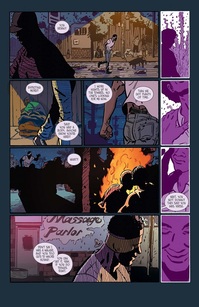 |
| Virgil p8 – Click to Enlarge |
So that’s a change; the coloring has been unified and sort of refreshed by JD and Chris; there’s a new foreword by David Walker, who’s a genius [Note from Jim: yes he is], and Blaxploitation scholar. He writes the Shaft comic, and he also writes the Cyborg comic at DC. And then we have a new cover by Artyom, my collaborator from Undertow. We have the debut of an illustration by my friend Chas Truog who did Animal Man with Grant Morrison. And so there’s some new stuff in there, and there’s, I think, an invaluable fine tuning that comes from the additional two years that we’ve had, of immersing ourselves in these stories and meeting people on a one on one basis, at least through email, that are living it day to day.
JD: You’ve mentioned in other interviews, you’ve talked a little about JFLAG [the Jamaican Forum of Lesbians, All-Sexuals and Gays]. Have you spoken with them about Virgil at all, or have they been providing feedback?
SO: I have not spoken with them directly, but I do direct everyone [there]for people who do want to try to participate or support their causes and things like that. They’re very accessible for support on the internet.
JD: I guess we’ll wrap it up with this. You mentioned that you’ve spent the intervening two years fine tuning some research, but it’s also been a pretty momentous two years in terms of your career. You’ve gone from a guy doing some independent stuff and the Kickstarter release and some Vertigo books to headlining Midnighter, getting a ton of press on that. You’re going to be one of the lead creators on the new big weekly Batman & Robin book. How has that changed your perspective on the work looking back now and getting a chance to revisit it?
SO: It’s been empowering, I guess is the answer, you know? I would have been nervous but still released Virgil if no one really knew what I was doing with those other things. But now that we’ve done Midnighter, and we’ve seen the joy and the validation it’s giving to the readers, I’m more confident than ever that it’s the right time for a book like Virgil to come out. And if it wasn’t for me, I would hope that it was by someone else. I shouldn’t say that as an either/or, I hope there are other books like Virgil and other queer-led books both in mainstream and in the independent and creator-owned arenas coming out. Because this is the time. This is the time to give people what they’ve had a little taste of, but there are infinite faces in the queer community alone, and so there are infinite stories to tell about them. And that applies to any type of underrepresented community.
So doing these other books and seeing how they affect people in positive ways has actually just made things even more urgent and even more imperative for me. Those books put more eyes on a book like Virgil, so it makes it more important that we get these ideas out there and that it’s a story that’s told, and it’s exciting for me to know that I’m not just sitting in Albany and screaming about this in my apartment. These are things that are affecting people in positive ways, and it makes it all the more exciting.
JD: Thank you so much!
******************************************************************
In case you haven’t guessed, I liked it a ton: Virgil is an unstoppable force of nature, almost John Wick-ian in his relentless plod towards revenge. And Faith and Beckett’s art is so good that I’ll be furious if they don’t see a higher profile from this. Virgil is on sale next week, September 9th, at your friendly local comic shop or online via Comixology.
